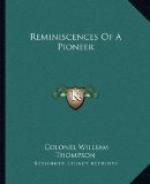Assuring ourselves that the renegades had not passed that point, and that they were further back, we started to meet them, meantime keeping a careful lookout ahead. We continued on to Crooked River and despairing of finding or overtaking them, we retraced our steps to camp, arriving there about dark after riding 75 or 80 miles.
The next day it was determined to send a strong detachment into the rough brakes of the South John Day. Accordingly Capt. Humphrey detailed 36 men and I joined him with the scouts. We were absent three days and returned to camp without encountering or seeing any signs of Indians. After resting our horses one day we again struck out, this time going farther north in the direction of Murderers Creek. The country was indescribably rough, and our first night’s camp was at the John Day at a point on the trail made by Gen. Howard when he was herding the Indians north. About 10 o’clock one of the men from a picket came in and told me that the Indians were signaling from two sides of the camp. I walked down to where Capt. Humphrey was sleeping and woke him up. We watched the signaling for a few minutes and then sent for Warm Spring Johnny. He said they were signaling that we were a strong party of soldiers and had come from the south. He then explained how the flashes were made. A pile of dry grass was collected and then surrounded by blankets. The grass was then fired and when the blaze was brightest the blankets on one side was quickly raised and again lowered, giving out a bright flash light.
I advised Capt. Humphrey to hold his men in readiness for a daylight attack, feeling certain nothing would be attempted until just at the break of day. We knew, however, they were not far distant and that great care was necessary. After discussing the situation with Capt. Humphrey it was determined to go on as far as Murderers Creek, striking the stream at the Stewart ranch. As we passed over the intervening space we saw abundant evidence of the presence of Indians and proceeded across the bald hills with caution. On the hill overlooking the Stewart ranch we saw quite a commotion, a cloud of dust raising and pointing back towards a deep, rocky, precipitous canyon. Believing the Indians were beating a retreat, we rode forward at the gallop, but arrived only in time to see the last of them disappear in the mouth of the canyon.
On the open ground at the mouth of the canyon we halted. The canyon presented a most forbidding appearance, and to follow an enemy of unknown strength into its gloomy depths was to court disaster. The canyon into which the Indians had been driven was steep, rocky and with the sides covered with brush, while the ridge was covered with scattering pines back to the timber line where rose the jagged, serrated peaks of the extreme summit of the mountain. After taking a careful view of all the surroundings we retreated down the mountain pretty much as we had ascended it.




